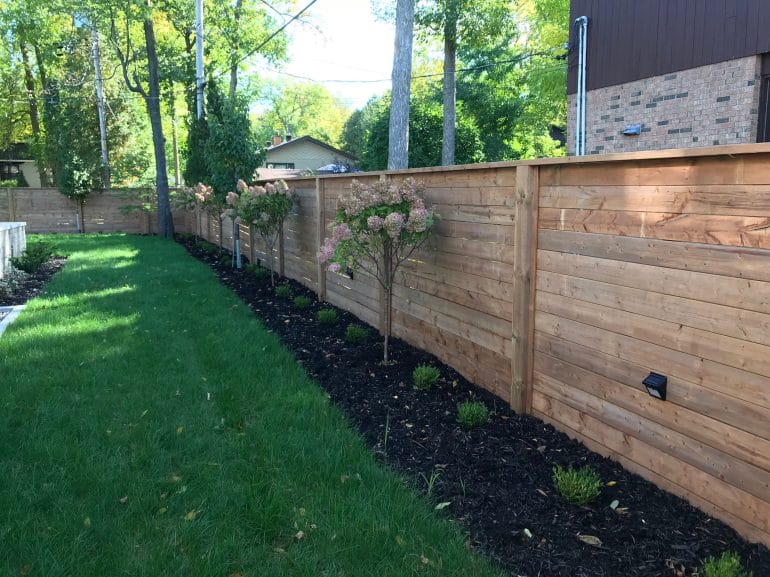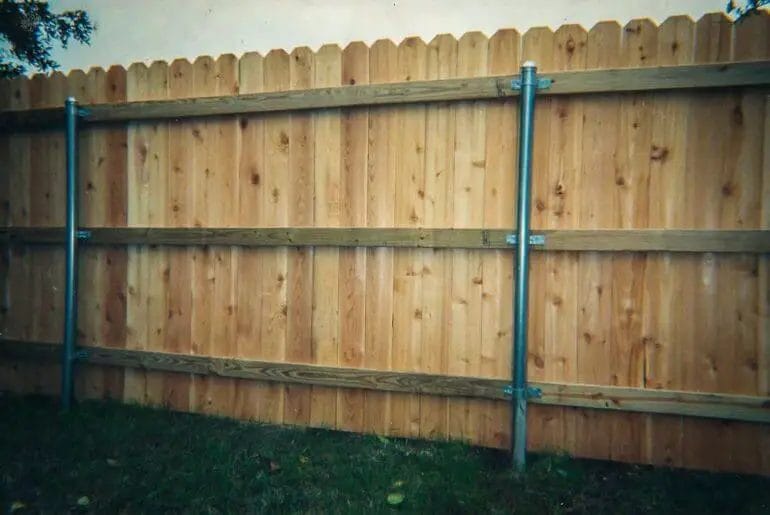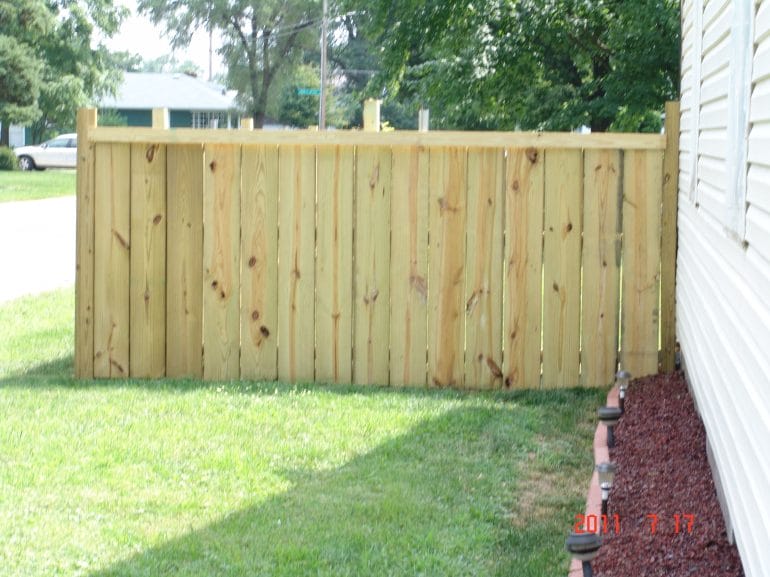If you’re considering building a fence, the choice of materials is crucial. One option to consider is using pressure-treated wood for your fence posts. Pressure-treated wood is infused with chemicals to make it resistant to rot, decay, and insects, making it a durable and long-lasting choice for outdoor projects like fences. In this article, we’ll explore the benefits of using pressure-treated wood for fence posts and help you make an informed decision for your fencing needs.

Choosing the Right Type of Wood for Fence Posts: A Guide
When it comes to building a fence, one of the most important decisions you need to make is choosing the right type of wood for your fence posts. The durability and longevity of your fence greatly depend on the quality of the wood you use for the posts. In this section, we will provide you with a comprehensive guide on how to choose the right type of wood for your fence posts.

1. Consider the Climate
Before selecting the wood for your fence posts, it is essential to consider the climate in your area. Different types of wood have varying levels of resistance to weather conditions such as rain, snow, and extreme heat. If you live in a region with high levels of moisture, it is crucial to choose a wood species that is naturally resistant to rot and decay, such as cedar or redwood. On the other hand, if you reside in an arid climate, you may opt for a wood species that is more resistant to sun damage, such as cypress or pressure-treated pine.
2. Evaluate Durability
Durability is a key factor when selecting wood for fence posts. You want your fence to withstand the test of time and be able to endure external elements without compromising its structural integrity. Some wood species, like cedar and redwood, naturally have a higher resistance to rot, decay, and insect damage. They are known for their exceptional durability and can last for decades. Other wood types, such as pressure-treated pine, go through a treatment process that enhances their durability and provides protection against rot, insects, and moisture.
3. Assess Maintenance Requirements
The maintenance requirements of the wood you choose for your fence posts should match your personal preferences and available time for upkeep. Some wood species, like cedar and redwood, have a natural resistance to rot and decay, which means they require minimal maintenance. These woods may only need occasional staining or sealing to maintain their appearance and longevity. On the other hand, other wood types, such as untreated pine, may require regular staining, painting, or sealing to protect them from rot and insect damage.
Table 1: Comparison of Wood Species for Fence Posts
| Wood Species | Climate Suitability | Durability | Maintenance Requirements |
|---|---|---|---|
| Cedar | High resistance to moisture | High | Minimal |
| Redwood | High resistance to moisture | High | Minimal |
| Cypress | High resistance to sun damage | Moderate | Minimal |
| Pressure-Treated Pine | Various | High (due to treatment) | Regular maintenance |
| Untreated Pine | Various | Low | Regular maintenance |
4. Consider the Budget
Another important aspect to consider when choosing the right type of wood for your fence posts is your budget. Different wood species have varying price points, with some being more expensive than others. Cedar and redwood, for example, are generally more costly due to their exceptional durability and resistance to rot. Pressure-treated pine, on the other hand, is a more cost-effective option that still offers good durability when properly maintained. By considering your budget, you can choose a wood species that meets both your aesthetic and financial requirements.
5. Aesthetics and Personal Preference
Your personal preference and the desired aesthetic of your fence should also play a role in your decision-making process. Each wood species has its unique appearance and color tones, which can greatly enhance the overall look of your fence. Cedar and redwood are known for their natural beauty and rich hues, making them popular choices for those who prefer a more rustic and timeless look. Cypress and pressure-treated pine offer different grain patterns and can be stained or painted to achieve the desired aesthetic.
Alternative Materials for Fence Posts: Exploring Your Options
When it comes to building a fence, choosing the right materials for the job is essential. While traditional wooden posts have long been the go-to option, there are now a variety of alternative materials available that can offer durability, sustainability, and aesthetic appeal. In this section, we’ll explore some of the most popular alternative materials for fence posts, allowing you to make an informed decision for your fencing project.
1. Metal Fence Posts
Metal fence posts, such as steel or aluminum, are gaining popularity due to their strength and longevity. They are resistant to rot, insect damage, and warping, making them an excellent choice for areas with harsh weather conditions. Metal posts can be used with a variety of fencing materials, including wood, vinyl, or chain link, making them a versatile option.
Additionally, metal posts are often more environmentally friendly than traditional wood posts. Many manufacturers use recycled materials, reducing the demand for new resources and decreasing the environmental impact of your fence.
2. Composite Fence Posts
Composite fence posts are a combination of wood fibers and recycled plastic. This innovative material offers the natural look and feel of wood but with enhanced durability and low maintenance requirements. Composite posts are resistant to rot, decay, and insect damage, making them a long-lasting and cost-effective option.
Furthermore, composite fence posts are an eco-friendly choice. By utilizing recycled materials, they help reduce waste and promote sustainability. They also require less maintenance than traditional wood posts, saving you time and effort in the long run.
3. Concrete Fence Posts
For those seeking maximum strength and stability, concrete fence posts are an excellent choice. Concrete posts provide exceptional durability and can withstand even the harshest weather conditions. They are resistant to rot, insect damage, and fire, ensuring your fence remains intact for years to come.
Moreover, concrete fence posts require minimal maintenance, eliminating the need for regular repairs or replacements. They can be used with a variety of fencing materials, including wood, vinyl, or chain link, giving you the flexibility to choose the style that best suits your needs.
4. Bamboo Fence Posts
If you’re looking for an eco-friendly and aesthetically pleasing option, bamboo fence posts are worth considering. Bamboo is a rapidly renewable resource that grows quickly and requires minimal water and pesticides to cultivate. It is also incredibly strong and durable, making it a viable alternative to traditional wood posts.
In addition to its sustainability, bamboo fence posts offer a unique and natural look to your fence. They can be used with bamboo panels or combined with other materials to create a custom design that enhances the beauty of your outdoor space.
5. PVC Fence Posts
PVC fence posts, also known as vinyl posts, are a popular choice for their durability and low maintenance requirements. They are resistant to rot, decay, and insect damage, ensuring a long-lasting fence that retains its appearance over time. PVC posts are available in various styles, colors, and textures, allowing you to create a fence that complements your property.
Furthermore, PVC fence posts are an environmentally friendly option. They are often made from recycled materials and can be recycled themselves, reducing the overall environmental impact. Their longevity also contributes to sustainability by minimizing the need for frequent replacements.
In summary, when considering alternative materials for fence posts, it’s important to weigh the factors of durability, sustainability, and aesthetic appeal. Metal, composite, concrete, bamboo, and PVC are all viable options that offer unique benefits for your fencing project. By exploring these alternatives, you can find the perfect material that meets your needs and enhances the beauty of your property.

Tips for Properly Installing and Maintaining Pressure Treated Wood Fence Posts
Pressure treated wood is a popular choice for fence posts due to its durability and resistance to rot and decay. However, improper installation and maintenance can significantly reduce the lifespan and effectiveness of your fence. In this section, we will discuss some essential tips for properly installing and maintaining pressure treated wood fence posts to ensure the longevity and stability of your fence.
1. Choosing the Right Type of Pressure Treated Wood
When selecting pressure treated wood for your fence posts, it is crucial to choose the right type of wood. Look for wood that has been treated with a preservative that is specifically designed for ground contact. This type of wood is treated to withstand the harsh conditions of being buried in the soil, ensuring long-lasting durability.
2. Digging the Post Holes
The depth and diameter of the post holes are critical factors in the stability of your fence. Dig the post holes to a depth that is at least one-third the height of the fence post above ground. For example, if your fence post is 6 feet tall, the post hole should be at least 2 feet deep. The diameter of the hole should be approximately three times the width of the fence post.
Additionally, it is essential to check for any underground utilities or cables before digging the post holes. Contact your local utility companies to mark the location of any underground lines to avoid accidents or damages.
3. Setting the Fence Posts
Before setting the fence posts in the ground, it is recommended to add a layer of gravel at the bottom of the post hole. This will help with drainage and prevent water from pooling around the base of the post, which can cause rotting over time.
Next, place the fence post in the hole and use a level to ensure it is perfectly vertical. Fill the hole around the post with concrete, leaving a slight mound at the top to allow for water runoff. Use a trowel to smooth the concrete and create a tapered shape that directs water away from the post.
4. Allowing Proper Drying Time
After installation, it is crucial to allow sufficient time for the pressure treated wood to dry before attaching any fence panels. This drying period allows the wood to stabilize and reduces the risk of warping or twisting. Follow the manufacturer’s instructions for the recommended drying time, which is typically around 24-48 hours.
5. Regular Maintenance
Proper maintenance is essential to prolong the life of your pressure treated wood fence posts. Regularly inspect the posts for any signs of damage, such as cracks or rot. If any issues are found, repair or replace the affected posts immediately to prevent further damage.
In addition, apply a wood sealer or stain every few years to protect the wood from moisture and UV damage. This will help maintain the appearance of the fence and extend its lifespan.
6. Protecting the Base of the Fence Posts
To further protect the base of the fence posts from rotting, consider using a post cap or concrete footing. A post cap provides an extra layer of protection against water penetration, while a concrete footing elevates the base of the post, preventing direct contact with the soil.
By following these tips for proper installation and maintenance, you can ensure the longevity and stability of your pressure treated wood fence posts. Taking the time to install and maintain your fence correctly will save you time, effort, and money in the long run, while also enhancing the aesthetic appeal of your property.
Longevity and Durability of Pressure Treated Wood Fence Posts: What to Expect
When it comes to building a fence, one of the most important considerations is the longevity and durability of the materials used. Pressure treated wood is a popular choice for fence posts due to its ability to withstand the elements and resist decay. In this section, we will explore what you can expect in terms of the lifespan and strength of pressure treated wood fence posts.
The Benefits of Pressure Treated Wood
Pressure treated wood is a type of lumber that has been infused with chemicals to protect it from rot, decay, and insect damage. This treatment process involves placing the wood in a vacuum chamber and applying high-pressure treatment chemicals. The result is a durable and long-lasting material that can withstand the harsh outdoor conditions.
There are several benefits to using pressure treated wood for fence posts:
- Rot Resistance: The chemicals used in pressure treatment are designed to prevent rot and decay, ensuring the longevity of the fence posts.
- Insect Resistance: Pressure treated wood is also resistant to insects such as termites, preventing damage that can weaken the posts.
- Weather Resistance: The treatment process enhances the wood’s ability to withstand moisture, UV rays, and other weather elements.
- Cost-Effective: Pressure treated wood is relatively affordable compared to other types of lumber, making it a popular choice for fencing projects.
Factors Affecting Longevity
While pressure treated wood offers excellent resistance to rot and decay, its longevity can still be affected by various factors. Understanding these factors can help you maximize the lifespan of your fence posts. Some of the key factors include:
- Soil Conditions: The type of soil your fence posts are installed in can greatly impact their durability. Well-draining soils are generally less likely to cause moisture buildup, which can lead to rot. On the other hand, clay or compacted soils can hold moisture and increase the risk of decay.
- Maintenance: Regular maintenance can significantly extend the lifespan of pressure treated wood fence posts. This includes applying a weather-resistant sealant or stain every few years to protect the wood from moisture and UV exposure.
- Exposure to Moisture: Direct contact with standing water or excessive moisture can accelerate the deterioration of pressure treated wood. Proper drainage and avoiding direct contact with wet soil or concrete can help mitigate this issue.
- Quality of Installation: The way the fence posts are installed plays a crucial role in their durability. Posts should be set in concrete footings to provide stability and minimize movement, which can cause stress on the wood.
Expected Lifespan of Pressure Treated Wood Fence Posts
The average lifespan of pressure treated wood fence posts can vary depending on the factors mentioned above. In general, you can expect pressure treated wood to last anywhere from 20 to 30 years, or even longer with proper maintenance.
However, it is essential to keep in mind that the lifespan of your fence posts is not solely determined by the wood itself but also the surrounding conditions and how well you maintain them. Regular inspections, repairs, and maintenance can help identify and address any issues before they worsen.
In summary, pressure treated wood is an excellent choice for fence posts due to its durability and resistance to rot, decay, and insects. By understanding the factors that affect longevity and taking proper maintenance measures, you can ensure that your pressure treated wood fence posts will provide years of reliable service.
FAQs
Should I use pressure treated wood for fence posts?
Yes, it is recommended to use pressure treated wood for fence posts. Pressure treated wood is treated with chemicals that protect it from rot, decay, and insect damage, making it more durable and long-lasting. This will ensure that your fence posts remain sturdy and strong for many years.
Conclusion
In conclusion, when it comes to using pressure treated wood for fence posts, it’s important to consider both the benefits and potential drawbacks. Pressure treated wood offers enhanced durability and resistance to decay, making it an appealing choice for outdoor projects such as fences. However, it’s also crucial to note that pressure treated wood contains chemicals that could potentially leach into the soil over time. To minimize any potential environmental impact, it’s recommended to use a barrier between the pressure treated wood and the soil. Ultimately, the decision to use pressure treated wood for fence posts should be based on your specific needs and preferences, keeping in mind the potential long-term effects.
When installing a fence, it’s important to carefully consider the type of wood you use for the posts. Pressure treated wood is a popular option due to its improved durability and resistance to rot. The chemicals used in the pressure treatment process help protect the wood from moisture, insects, and decay. However, it is worth noting that pressure treated wood does release some chemicals over time, which may have potential environmental implications. To mitigate any risks, considering using a liner or plastic sleeve between the wood and the soil. Ultimately, the decision to use pressure treated wood for fence posts should be made based on the specific circumstances and your personal preferences.
